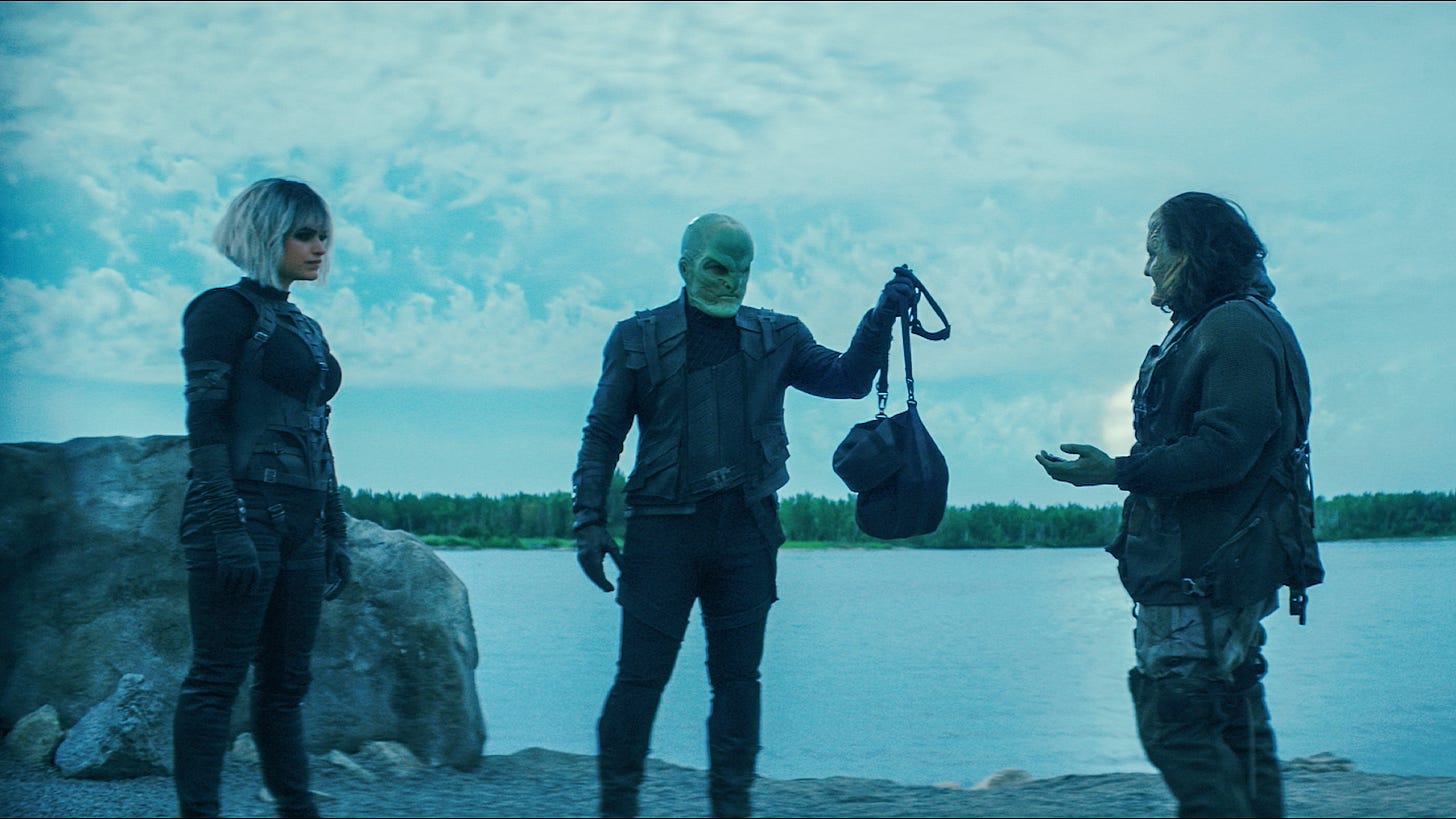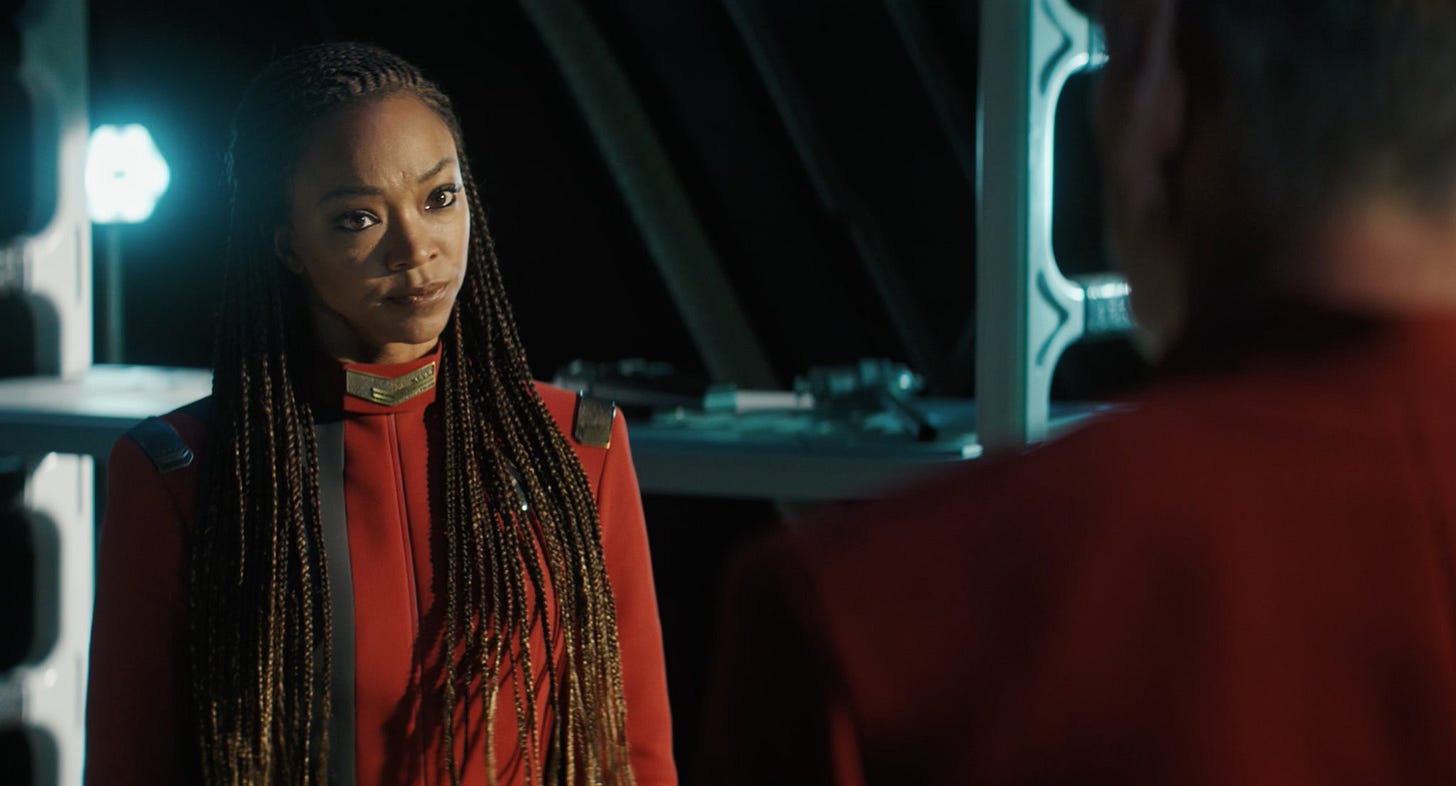Star Trek: Discovery Affirms the Open-Hearted Approach of the Series and its Captain in "Face the Strange"
A time-hopping adventure turns into a referendum on whether Michael Burnham's looser but friendlier command style works.
CAUTION: This piece contains major spoilers for S05E04 of Star Trek: Discovery - “Face the Strange”
The best high concept episodes don’t just coast on the novelty of their premise; they use the format-bending nature of the story to mean something. “Face the Strange” is a rollicking good time-jump episode of Discovery in the long proud tradition of the franchise. Discovery has tons of fun frolicking through the series’ history, indulging in some good ol’ fashioned temporal problem solving and bringing back characters who have passed. That alone would be more than enough to sustain an hour of entertainment.
But “Face the Strange” goes one important step further. The episode harnesses that conceit to help Commander Rayner understand the value of the culture aboard Discovery, and affirms just how far Burnham has come.
The plot sees the troublemakers Moll and L’ok siccing a “time bug” onto Discovery. The little temporal pest ties our heroes up while the conniving smugglers beat them to the next clue. (The script includes nice nods to the Krenim from Voyager and the Temporal War from Enterprise for the diehards.) The plan would be a big success for the bad guys except, for once, the futuristic laziness of beaming to places you could easily walk comes in handy.
Since Burnham and Rayner were mid-transport when the bug hit, they’re (relatively) unaffected by its temporal effects and can work on the problem. At the same time, Stamets’ tardigrade DNA means he too exists outside of time in a way that gives him an awareness of the time skips, separate and apart from the rest of the crew.

Look, this is Star Trek, which is another way of saying that this is all nonsense. But one of the sharpest elements of the script is how the writers offer just enough fig leaves and intuitive (if fanciful) technical explanations for the timey-wimey nonsense to give the proceedings the perfect veneer of plausibility.
The way Burnham, Rayner, and Stamets progress through the problem never feels arbitrary. Instead, they gather data on the time between jumps and spatial distances to calculate how much time they have In each temporal stopover. They have to pool data and observations in order to build a model and find the right materials in the right time period to construct a solution. Even the time-speeding relativity field that protects the bug, that can only be matched by the relativistic speeds of warp travel, gives their scientific problem solving a patine of light sci-fi credibility, that befits a Star Trek series.
The group’s mini-breakthroughs along the way help keep up the momentum of “Face the Strange”. There’s a thrill every time our trio of unstuck-in-time heroes figure out some piece of the puzzle amid the temporal and spatial resets. Each new technical epiphany poses a new practical problem for the time-hoppers to overcome. Each new pragmatic solution unlocks a new scientific setback to parse through. The strong sense of escalation and complication means the time travel trip-up never seems stale or static, which helps keep up the excitement on a nuts and bolts level. This is a sound story, when it would be very easy not to be given the time travel nonsense that abounds.
What’s more, you could easily get away with plying the audience with visits to different eras of the show and glimpses of what’s to come. Thankfully, in contrast to other episodes from this season, “Face the Strange” isn’t bogged down by the heavy plot machinery of the season arc.
There is a discussion of how our heroes need to solve this problem so as not to be outfoxed by L’ok and Moll. And there’s a bracing visit to a grim future, reminiscent of the “Calypso” Short Trek. In that bad timeline, we see a decimated Federation HQ in a galaxy where the smugglers sold the Progenitor tech to the highest bidder, to the detriment of all that is good and holy. But this only serves to set the stakes for the immediate problem (and, admittedly, the race against Moll and L’ok), rather than focusing the adventure on mechanical progress through the seasonal scavenger hunt.
The break allows the show to take something of a victory lap. The creative team reportedly did not know this would be the series’ final season, but “Face the Strange” is, accidentally, the perfect episode to include in the last leg of Discovery’s voyage. I can’t pretend to harbor a ton of affection for the clash with Control or the skirmish with Osyrra. And despite name-dropping Lorca, we don’t get many cameos from the show’s prior players – not even the Strange New Worlds cast who are presumably fairly available.
But it’s fun to see the old uniforms brought out of storage, to hear Paul reference his more prickly beginnings on the ship, and to see the different reactions the characters have to one another, on both sides of the time-dilation equation. More than that, there remains something winning, and a little humbling, about seeing Burnham and Stamets revisit and take stock of the high points and low points the U.S.S. Discovery has been through over the years, and invites the audience to do the same.
No one embodies the scope and change along that journey better than Michael Burnham. In truth, it’s hard to draw a straight line between the gruff pariah who began the series to the open-hearted captain who leads it now. Changes in the show’s creative team and reformulations of the character can make the Burnham of the 23rd century and the 32nd century seem like different people. But to this episode’s credit, it leans into that difference. Burnham’s evolution becomes one of the episode’s key themes, about how much that openness and perseverance can make an enervating, life-changing sort of growth possible.
Of course, the idea comes to a head when current Burnham locks horns with her past self. In a canny bit of writing, past Burnham is extra suspicious that something is afoot, because she doubts that a mutineer specialist could ever rise to the rank of captain. The confrontation between the two incarnations of our protagonist gives Discovery a chance to invoke and improve on that classic Original Series chestnut of Kirk regularly finding ways to go mano-a-mano with himself.
But they also give modern Burnham a chance to realize how far she’s come, not just in terms of rank, from a time when she was hopeless and searching for meaning, to one where she has a support system and purpose. One of the season’s overarching themes is that broader search for meaning, and it’s nice to see how that’s realized on a personal level for Burnham when reflected through who she used to be.
It also comes through in the one cameo we do get – from Airiam. She’s the commander on the bridge when modern Burnham bursts through spinning some implausible tale about time travel and catastrophic threats at a time when she’s best known for hoodwinking her commanding officer and starting a war.
Only, what persuades the bridge crew to listen to her is not a raft of technobabble or appeals to Starfleet protocol. Instead, it’s an appeal to the personal connections Burnham has forged with Tilly, Airiam, and the members of the B-Team over the years. Granted, Michael conveying how she knows that Airiam would sacrifice her life for the greater good seems a little thin and general to convince an officer than an apparent mutineer is telling the truth about needing to rip the ship out of its warp bubble. But the goodwill “Face the Strange” generates, both from its engaging adventure and the warm feelings between Burnham and her friends, is enough to let it suffice for the point the show wants to make.
That point is a vindication of the culture aboard Discovery, the one that Rayner bristles at. He’s used to a professional distance, a rigid chain of command, and a command structure that favors discipline over camaraderie. The writers are clever to use a time travel story, one where solving the practical problem of the moment depends on established and establishing trust with your fellow officers, to draw the merits of Burnham’s approach out. Modern Burnham wouldn’t be able to make such a crazy request of people who think the worst of her, and succeed, if she hadn’t taken the time to build a rapport with them over the years, and fostered the environment that made it possible.
True to the Bowie homage of the title, “Face the Strange” honors the changes among the Discovery faithful, and effects one in Rayner. He survives an onslaught from Emerald Chain goons thanks to the kindness of Jet Reno (Tig Notaro), who treats him with more compassion and consideration as a stranger than he did for her as a subordinate. He witnesses how the openness Burnham nurtures on the ship allows her and Paul to not only collaborate with shorthand and ease, but turn to their friends, past and present, for help when they desperately need it. And he himself takes the same approach, forging a connection with Rhys, and speaking earnestly to Specialist Burnham about the person she’ll become, just in time to garner just enough trust for him and his future-bound cohort to save the day.
It is an object lesson on why the kinder, more familial tack aboard Discovery succeeds that changes Rayner’s perspective, as he sees how effective it can be in action when it counts most. His closing exchange with Michael underlines the point a bit too bluntly for my taste, but the point is a good one. It’s a rebuke to the Captain Jellicos of the world, both in-universe and the real world, who think rigid hierarchies and strict discipline are the only paths to success. And, not for nothing, it’s a way to honor the notion ship-as-family that’s been with the franchise since The Next Generation. Discovery exists in that proud tradition, and “Face the Strange” affirms how the onetime flagship of the franchise still bears that banner.
In that, Discovery delivers its best episode of the season to date, and one of the best of the series. The high concept time-hops make for a thrilling romp. It comes with the novelty of revisiting the show’s history and the coolness of our heroes thinking, working, and scheming their way out of the problem.
But this is also Discovery’s best vindication of its Captain, and what she’s accomplished for herself and her crew over the years. And it’s a compelling story of a skeptical outsider taking to heart, in strange but serious circumstances, why the sense of connection, camaraderie, and trust that the series is founded on, are more than worthwhile. Burnham and Rayner may not be able to change time just yet, but here and now, time’s managed to change them both.






